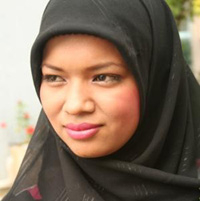News
Cultural Dimensions of Safe Childbirth in Thailand
- 12 November 2008
News
HAT YAI, Thailand– Nurama ‘Mee’ Jaedo is a young woman with a mischievous smile and no regrets, even though the baby she had at the age of 16 was not planned.
“I was on the Pill, but sometimes I forgot to take it, so I got pregnant early. It’s common among my friends – many of them also had children early,” says Mee, a Thai Muslim from the country’s conflict-affected Narathiwat province.

Mee, now 20 years old and a mother of two, was married at 15. She delivered both her sons at a hospital without complications. But not everyone is as lucky: Mee’s home province suffers from one of the highest maternal mortality rates in Thailand. Many pregnancy and childbirth-related deaths and injuries across the developing world are preventable. While Thailand has made great progress in maternal health, there remain disparities within the country. Isolated, hard-to-reach populations, including ethnic minorities and women affected by conflict, are often underserved and, therefore, most vulnerable.
Cultural dimensions of childbearing
Saving women’s lives depends on access to quality care during pregnancy and childbirth, emergency services to deal with complications, and a range of family planning options to allow women and couples to plan their families and avoid unintended pregnancies, according to UNFPA, the United Nations Population Fund.
But beyond medical services provided by competent staff, saving women’s lives requires a deep understanding of the cultural influences that impact the reproductive health choices people make. Despite the availability of skilled birth attendants and hospital services in Narathiwat, for example, about 10 per cent of women there still prefer to deliver at home with traditional birth attendants, some with tragic consequences.
“Numerous factors prevent people from accessing and using the services they need, even if they are available,” says Mr. G. Giridhar, the UNFPA representative in Thailand. “Barriers can include gender stereotypes and women’s reluctance to use facilities with which they feel they have no cultural connection. Culturally sensitive programming is crucial to the work of development agencies like the UNFPA, which aims to promote reproductive health and rights in the broader context of human rights.”
In Thailand, UNFPA is working to improve sexual and reproductive health by bringing information and services to those who need them most. A deep understanding of the needs and aspirations of the community, and their acceptance and ownership of these efforts are crucial. UNFPA works with partners to study community beliefs and practices and identify those most supportive of human rights, women’s empowerment and gender equality. This is easier said than done, but according to the Fund, a sincere effort at the programme formulation stage has proved to be extremely valuable. Promoting men’s participation in maternal health, for example, has been an important part of the strategy in some vulnerable areas.
Cultural fluency: a precondition for successful programming
“Analysing people’s choices in their local conditions and cultural contexts is a precondition for better policies and programmes,” says Mr. Giridhar, citing UNFPA’s annual report on The State of World Population, which is being launched globally today. This year the focus is on the importance of integrating culture into development work.
Mee’s community offers an example of the dynamic nature of cultures that the report highlights. In her family, Thai beliefs about childbirth interact with Islamic custom. As health and other services in her village improve, Mee and others are embracing new influences. Hospital deliveries are increasing, for example.
Efforts by UNFPA and its local partners to provide family planning services in a culturally acceptable way have allowed Mee to make better informed choices about her future. She wants one more child, a sister for her two boys. But before that, she dreams of becoming a computer teacher.
by Laura Vinha